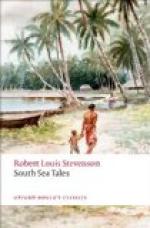Yet the work was accomplished. By dusk, when his majesty withdrew, the town was founded and complete, a new and ruder Amphion having called it from nothing with three cracks of a rifle. And the next morning the same conjurer obliged us with a further miracle: a mystic rampart fencing us, so that the path which ran by our doors became suddenly impassable, the inhabitants who had business across the isle must fetch a wide circuit, and we sat in the midst in a transparent privacy, seeing, seen, but unapproachable, like bees in a glass hive. The outward and visible sign of this glamour was no more than a few ragged coco-leaf garlands round the stems of the outlying palms; but its significance reposed on the tremendous sanction of the tapu and the guns of Tembinok’.
We made our first meal that night in the improvised city, where we were to stay two months, and which—so soon as we had done with it--was to vanish in a day as it appeared, its elements returning whence they came, the tapu raised, the traffic on the path resumed, the sun and the moon peering in vain between the palm-trees for the bygone work, the wind blowing over an empty site. Yet the place, which is now only an episode in some memories, seemed to have been built, and to be destined to endure, for years. It was a busy hamlet. One of the maniap’s we made our dining-room, one the kitchen. The houses we reserved for sleeping. They were on the admirable Apemama plan: out and away the best house in the South Seas; standing some three feet above the ground on posts; the sides of woven flaps, which can be raised to admit light and air, or lowered to shut out the wind and the rain: airy, healthy, clean, and watertight. We had a hen of a remarkable kind: almost unique in my experience, being a hen that occasionally laid eggs. Not far off, Mrs. Stevenson tended a garden of salad and shalots. The salad was devoured by the hen—which was her bane. The shalots were served out a leaf at a time, and welcomed and relished like peaches. Toddy and green cocoa-nuts were brought us daily. We once had a present of fish from the king, and once of a turtle. Sometimes we shot so-called plover along on the shore, sometimes wild chicken in the bush. The rest of our diet was from tins.




